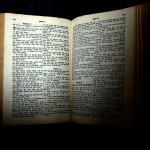This is the second post in a series on 1 John. The point of this series is to illustrate how exegesis is done by “doing” a bit of exegesis in a rather step-by-step fashion. The first post dealt with author and genre. This one deals with the literary relationships between the Johannine Epistles and the remainder of the Catholic Epistles, the Gospel of John, and the rest of the NT.
Although I neglected to mention it in the first post, the content of the first four or five posts will cover what we might call “introductory matters.” It is easy to be impatient with the time it takes read this sort of thing. It is my experience, however, that it is invariably time well-spent. There is no substitute for context when you try to interpret a literary work.
Finally, Eric reminds me in a comment on the first post that part of this illustration should be to show how I use the various sources and tools that go into something like this. So I will!
LITERARY RELATIONSHIPS: THE JOHANNINE EPISTLES
In the last post, I proposed that the relationship between 1 John and 2 John was that the latter was a cover letter for the transmission of the former. This, I think, is a good approach given that Irenaeus (d. 202 CE) seems to have thought that the two were one document. Sometimes 1 John is found alone, but this might be explained by the fact that the Elder would not have used a cover letter for his own church or those that were very nearby.
What about 3 John?
Here is the text of 3 John from the NAB. (If you are going to take your study of the Bible seriously, consider getting a modern translation, preferably in a study Bible. The AV is nice but your study time will be far more productive if you are not constantly struggling to deal with some of the shortcomings of its translation.) Anyway, here’s 3 John:
The Presbyter to the beloved Gaius whom I love in truth. 2 Beloved, I hope you are prospering in every respect and are in good health, just as your soul is prospering. 3 I rejoiced greatly when some of the brothers came and testified to how truly you walk in the truth. 4 Nothing gives me greater joy than to hear that my children are walking in the truth. 5 Beloved, you are faithful in all you do for the brothers, especially for strangers; 6 they have testified to your love before the church. Please help them in a way worthy of God to continue their journey. 7 For they have set out for the sake of the Name and are accepting nothing from the pagans. 8 Therefore, we ought to support such persons, so that we may be co-workers in the truth. 9 I wrote to the church, but Diotrephes, who loves to dominate, does not acknowledge us. 10 Therefore, if I come, I will draw attention to what he is doing, spreading evil nonsense about us. And not content with that, he will not receive the brothers, hindering those who wish to do so and expelling them from the church. 11 Beloved, do not imitate evil but imitate good. Whoever does what is good is of God; whoever does what is evil has never seen God. 12 Demetrius receives a good report from all, even from the truth itself. We give our testimonial as well, and you know our testimony is true. 13 I have much to write to you, but I do not wish to write with pen and ink. 14 Instead, I hope to see you soon, when we can talk face to face. 15 Peace be with you. The friends greet you; greet the friends there each by name.
First, this one is clearly a personal letter. It has both a salutation and closing; the correspondents are individuals, and the content is informal. I must also call your attention to the word “friends” in v. 15. I wonder, but do not know for certain, if this is at least part of the background behind the way the Society of Friends (Quakers) uses the expression.
Second, it is possible that, if it were not for the fact that this letter comes from the Elder, it might never have been preserved. It has some fascinating insights, though. You might have expected that the Elder was a person of importance, and that contravening his wishes would have serious consequences, but this is hardly the case:
9 I wrote to the church, but Diotrephes, who loves to dominate, does not acknowledge us. 10 Therefore, if I come, I will draw attention to what he is doing, spreading evil nonsense about us.
He’s going to “draw attention” to the situation? Wow! This weak reaction supports, I think, the idea that I alluded to earlier that the Johannine community had little in the way of a hierarchical authority structures. Nevertheless, they obviously still had issues with power and authority. Flat organizations sound appealing; in practice I think you will eventually agree that in this case it seems to have presented some very serious challenges to the stability of the group.
Most pertinent to our immediate purposes, however, is the fact that while there’s a conflict, it’s not so obviously the one that shapes 1 and 2 John. It is natural to think that Diotrephes is one of the original “bad guys” but the Elder is not calling him an antichrist, a deceiver, or any of the other terms of endearment that speckle 1 and 2 John. At stake is simply what we might call hospitality for missionaries. This was a critical aspect of life among early Christians, who took that injunction about “without purse or scrip or shoes” (Lk 22:35) very, very seriously. Without support from local Christians, there would have been no spread of the gospel.
It is impossible to discern whether Diotrephes merely resented the Elder’s exercise of authority in 2 John, whether he had some sympathies with the Elder’s opponents, or whether it was none of the above. For my purposes in interpreting 1 John, it is sufficient to note the Elder’s rather weak position in his community, and to raise the idea that there may have been other conflicts beyond the one that will dominate 1 John.
For an approach to 2 and 3 John that attempts to avoid reading them “in the shadow of, and along the lines determined by, the Gospel, and First Epistle,” see Judith Lieu, The Second and Third Epistles of John.”
FTR (For the Record): This is an interpretive issue. The first step is to read the texts in question yourself and develop your own conclusion and supporting arguments. Then you can check a selection of commentaries for other opinions and arguments. Sometimes you will find widespread agreement; sometimes not. This case is a mild version of the later. A good commentary will make a “call” and then cite more extensive secondary literature for those who wish to pursue the matter. It is not necessary for a commentary to engage every argument on every issue, for a great deal has been written on the Bible, but beware the commentary that neglects to identify major interpretive cruxes and provide sources!
LITERARY RELATIONSHIPS: THE CATHOLIC EPISTLES
The Johannine Epistles are part of a larger group of NT writings known as the Catholic Epistles. These seven epistles, found just ahead of Revelation in the NT, are bounded by James and Jude. It may be significant that there are precisely seven, and that James and Jude are brothers of Jesus but no one really knows for certain.
The designation of these epistles as “catholic” reflects the idea that they were all written to a wider audience than a single city. In this context, the expression “catholic church” means “universal church.” Their opening sentences betray this facet:
James: James, a servant of God and of the Lord Jesus Christ, to the twelve tribes which are scattered abroad, greeting.
1 Peter: Peter, an apostle of Jesus Christ, to the strangers scattered throughout Pontus, Galatia, Cappadocia, Asia, and Bithynia, 2 Elect according to the foreknowledge of God the Father, through sanctification of the Spirit, unto obedience and sprinkling of the blood of Jesus Christ:
2 Peter: Simon Peter, a servant and an apostle of Jesus Christ, to them that have obtained like precious faith with us through the righteousness of God and our Saviour Jesus Christ:
Jude Jude, the servant of Jesus Christ, and brother of James, to them that are sanctified by God the Father, and preserved in Jesus Christ, and called:
Unlike more homogeneous NT sub-groups, these seven works are very diverse. Their situations are very different, their theologies are distinct, and the ethical advice is usually correspondingly specific. What they have common is their universal address – all except for the Johannine Epistles, of course!
FTR: The place to find this sort of information is a Bible dictionary. The “gold standard” is the six [really big] volumes of the Anchor Bible Dictionary. You will find a copy of this in the reference section of many public libraries and pretty much all the academic ones. Both Eerdmans and Harper-Collins publish one volume dictionaries, and the serious student of the Bible always has one close at hand. It will give you invaluable background on details such as places, names, and events. I know that the price of the one bound in your KJV is just right, but it is very old and it “mormonizes” some topics with regrettable results.
LITERARY RELATIONSHIPS: THE GOSPEL OF JOHN
This is possibly the most important bit of historical and literary background required in order to interpret 1 John. What is the relationship of 1 John to the Gospel of John, and which came first?
The Evidence Against Common Authorship
The literary evidence against a common author for the Fourth Gospel and 1 John depends on comparisons of words used, syntax, and thematic similarities. For example, the symbolism in the Gospel is very creative and diverse. John uses relatively few words with very simple syntax, and yet manages to create some of the most memorable lines in the NT. These lines illuminate the most exalted Christology in early Christianity. The Elder works with a very similar Christology and symbolic universe, but has produced a text with syntactical ambiguities in almost every verse! There are also a number of places where it is hard to conclude that he is anything other than logically inconsistent. Although the evidence is inconclusive, these distinctions suggest that the same person did not write both texts.
FTR: Evangelical scholars typically examine the same evidence used to produce this conclusion and yet conclude that John the Apostle is, in fact, the author of pretty much everything ascribed to him by the 2nd century titles of each work. This is very much a minority opinion but you will see it if you begin to use commentaries.
I note with interest that Professor Stephen Smalley’s commentary on the Johannine Epistles in the Word Biblical Commentary, which is broadly evangelical, attributes the Epistles to someone other than the author of the Fourth Gospel. But it also goes on to say “we may assume that [he was a] leading and probably ordained Johannine Christians. Hm. You would certainly have to assume it, since the text says nothing of the sort.
Commentaries are not infallible. Caveat lector!
The Evidence For Thematic Continuity
Although the grammatical style in the Fourth Gospel and 1 John is quite divergent, they have a very similar world view called “dualism.” This approach to Life, the Universe, and Everything divides all of existence into two camps such as light and dark, truth and lies, or what is from above against what is from below. This is particularly pronounced when it comes to classifying people. The sons of light are those who decide to believe the message of Jesus; the sons of darkness are those who do not. John Painter (1, 2, and 3 John in the Sacra Pagina) calls this a “dualism of decision” to distinguish it from a more deterministic understanding.
This dualism plays out in a shared diction. Using Bibleworks, a database used by many Bible dorks (our own Nitsav is something of an expert), I can pull up and compare every instance of every potentially significant word in both texts. I will share some of the results with you. Remember that 1 John is about 1/6th the length of the Fourth Gospel:
• “truth” appears 25 times in John and 9 times in 1 John
• “sin” appears 17 times in John and 17 times in 1 John!
• “light” appears 23 times in John and 6 times in 1 John
• “dark” appears 8 times in John and 6 times in 1 John
Adjusting for disparities in the length of each text, these words, and the ideas associated with them, are far more prevalent in Johannine literature than in pretty much any other book in the NT.
Lengthier instances of repetition or near repetition also show that the intellectual world of the two texts is not far apart:
John: you are of your father the devil (8:44)
1 John: he is of the devil (3:8)
John: shall not walk in darkness (8:12)
1 John: he walks in darkness (2:11)
John: he has passed from death into life (5:4)
1 John: we have passed from death into life (3:14)
John: the Son abides forever 8:35)
1 John: the one doing the will of God abides forever (2:17)
In addition, the structure of 1 John is similar to that of the Gospel. The correspondence between the Prologue of the Gospel and that of 1 John is particularly striking as a small number of samples from Raymond Brown’s Anchor Bible analysis demonstrates:
John 1:1a in the beginning was the word
1 John 1:1a what was from the beginning
John 1:4a in him [the Word] was life
1 John 1:1f the word of life
John 1:5a the light shines in the darkness and the darkness did not overcome it
1 John 1:5e and in Him [God] there is no darkness at all
FTR: only longer commentaries, such as those by Painter and Brown, have this sort of word and phrase analysis. Shorter commentaries will allude to it and give a citation.
This last example illustrates something that actually distinguishes 1 John from the Fourth Gospel: in the Gospel, the light that is not overcome is Jesus, while in 1 John the reference to light is an allusion to God. This brings us to Raymond Brown’s list of differences from his Introduction to the New Testament:
• The Prologue of John emphasizes the incarnation of the Word, while the Prologue of 1 John talks about the word (message) of life that was heard – the human career of Jesus
• 1 John assigns to God features that the Fourth Gospel assigns to Jesus. In addition to the example mentioned above, I might also note that the love command in 1 John comes from God rather than Jesus
• 1 John is not so “clear” that the Spirit is a person and it never uses the term “Paraclete” (AV= “Comforter,” but really “advocate”) to refer to the Spirit. Christ is the Paraclete in 1 John.
• Parallels with the Dead Sea Scrolls are stronger in 1 John than in John
• The eschatology in 1 John is final, while that of the Gospel is realized. This means that the Gospel teaches that salvation is here now, while 1 John still looks forward to it.
So it appears that while the two works, that is, the Fourth Gospel and 1 John, were not written by the same person, they do share very significant theological ideas. This brings us to the question of priority.
FTR: It you want a one volume commentary on the NT you could do far worse than the book by Brown that I just cited.
Which Came First, the Gospel or the Epistle?
Although there is some debate, I believe that the majority opinion is pretty overwhelmingly in favor of the priority of the Gospel. This does not mean that the Gospel was completely in the form we now find it, because the Elder may be among those who wrote chapter 21, but that the ideas and even much of the language used to express those ideas were already in place.
Since this post has gone on far toooo long, I turn straightway to Painter for his summary of why this is so. First, in addition to sharing a similar prologue, the closing of both the Gospel and 1 John are similar in that the “real” closing comes well before the end. There is a good reason for the addition of chapter 21 in the Gospel, but a similar excursus on the end of 1 John looks like stylistic imitation. Second, the stated purpose of the Gospel is that the readers might believe, to which end the rhetorical strategies of the Gospel are bent. 1 John, on the other hand, is written to those who already believe in order to assure them that they are on the right track. Finally, in John the main source of conflict is with the Jews. This suggests that John was written just as Christianity and Judaism bitterly went their separate ways. In 1 John, there is no mention of the Jews, suggesting that this conflict is in the past. Instead, the Elder’s audience seems to be Gentiles, since there are no quotations from the OT, and the conflict is between various groups within the Johannine community.
So… The [mostly, maybe, complete] Gospel is dated to about 90 C.E. and 1 John to a few years later. The two works have different authors, but the Elder, the author of 1 John, is deeply immersed in the traditions of the Fourth Gospel and draws on them at length and in detail.
NEXT UP: The situation: what was the crisis that sparked 1 John?











